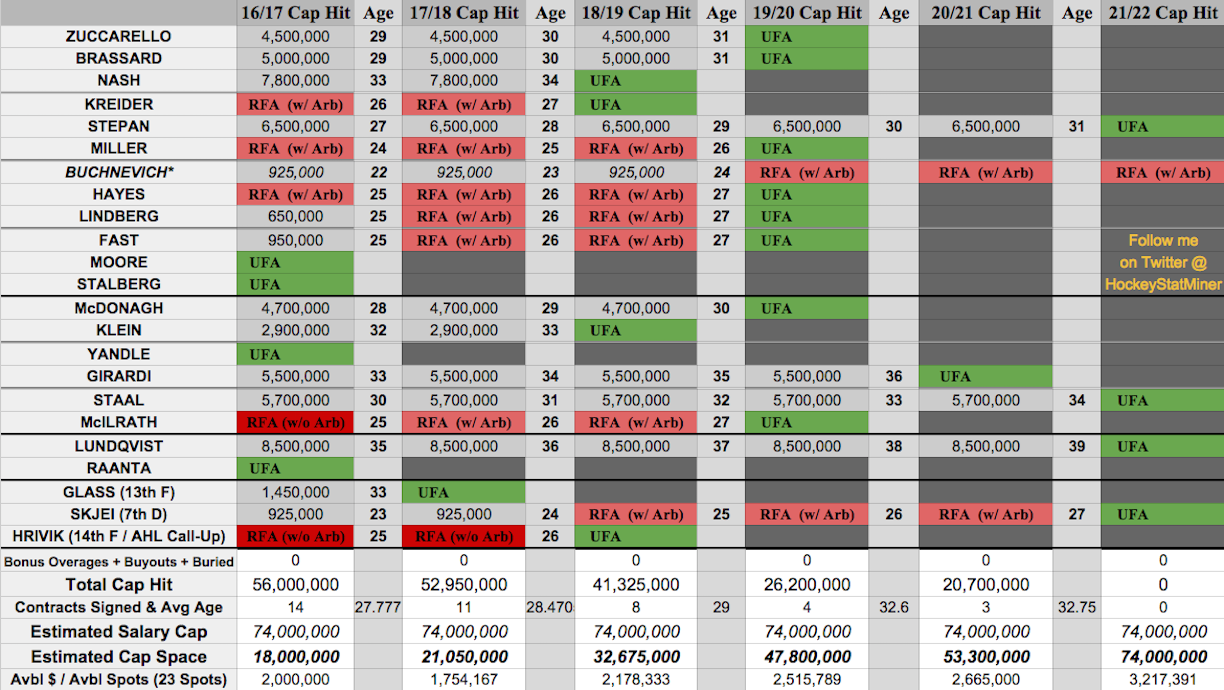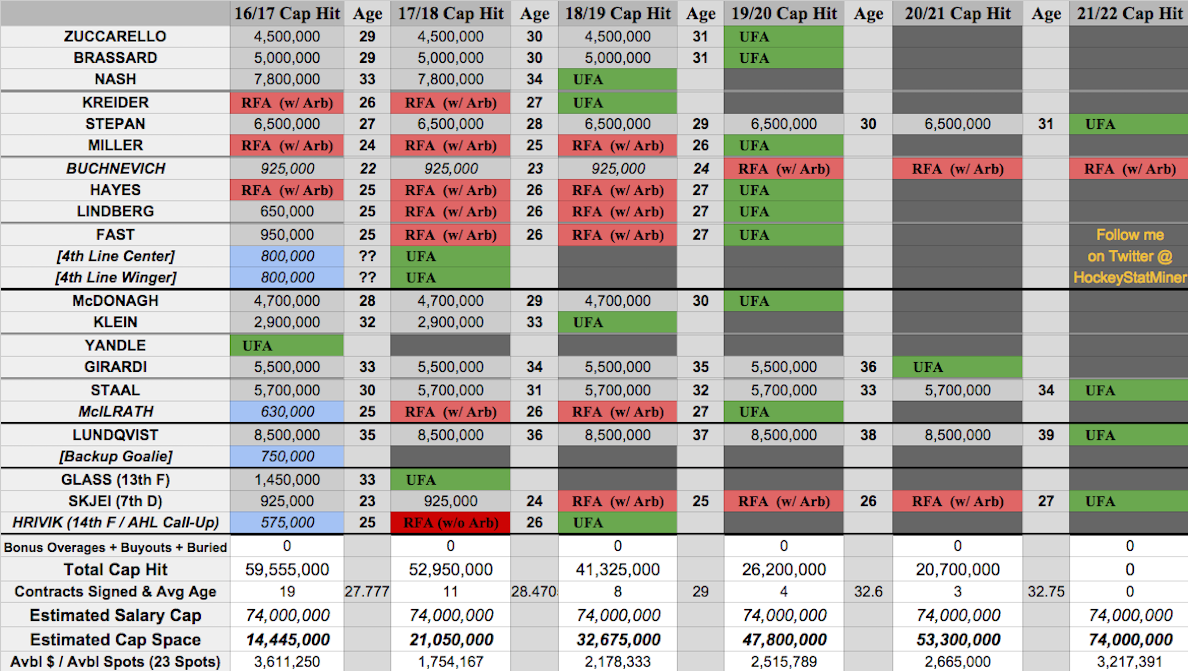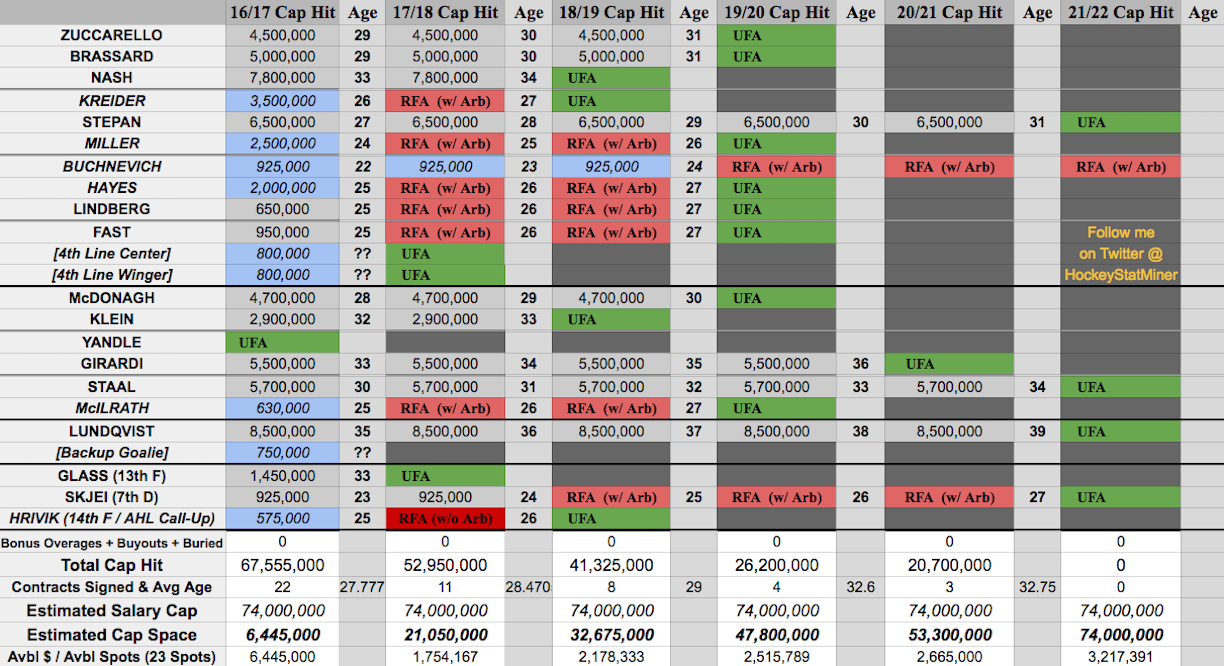What Could A $74 Million Salary Cap in 2017 Mean for the NY Rangers?
Could the inflated salary cap help the Rangers?
News last week revealed that the National Hockey League’s 2016-17 salary cap could rise to as much as $74 million, despite the pessimism plaguing the 2015-16 season as both the Canadian dollar & Canadian NHL franchises have bottomed out. For teams already packed to the gills in club payroll (teams like... you know... the New York Rangers); such news is invariably good news. So I’d like to take a few moments to examine how such an increase in available spending could impact the Rangers’ decisions come summertime.
The chart below is exactly what Jeff Gorton is on-pace to be looking come the off-season. However, I’ve made three key assumptions:
1) Dan Boyle is not featured, as his contract is over after the current season, and it seems extremely unlikely he will return in any way.
2) Eric Staal is similarly not featured, for similar reasoning. Though, unlike Boyle, it will probably be due to overwhelming demand from other teams.
3) Pavel Buchnevich is assumed to finally come over from Russia, and sign an NHL entry-level contract (ELC) with New York, and make the team out of training camp. The demonstrated $925,000 per year cap hit is the maximum allowed under an ELC, and frankly, a standard assumption for an A-List prospect such as Buchnevich.

A $74 million salary cap next season would permit Broadway with $18 million in space to deal with the eight or nine vacant spots. The three key Restricted Free Agents (RFAs) to manage are obviously Kevin Hayes, Chris Kreider & J.T. Miller; all of whom have the right of salary arbitration in July. The lone major Unrestricted Free Agent (UFA) is Keith Yandle, whom we’ll get to in a bit.
So in the interest of sculpting a better picture for what options Gorton has with the major personnel, let’s make some more assumptions regarding the smaller pieces.
Dylan McIlrath: A pleasant surprise this season, as most of us (I included) didn’t think he’d make it out of training camp. His minimum qualifying offer will be $630,000 (105% of his 2015-16 salary). He does not have the right of salary arbitration, and is unlikely to be offer-sheeted by another NHL club, and therefore has no leverage. Similar to that of John Moore in the summer of 2014, I’d suspect he signs for his minimally tendered offer on a 1-year bridge deal.
Dominic Moore: The veteran fourth-line center could very well end up re-signing, or the Rangers could go another way. The point being, I would look for the team to, one way or the other, plan on keeping fourth-line payroll to a bare minimum. There is the possibility of signing Moore to a very small 1-year contract, with it being heavily loaded with performance bonuses, as to save on cap space & keep Moore well paid versus the open market. In any event, whether it be Moore or a free agent, we’ll assume the 4th center spot to account for only $800,000.
Viktor Stalberg: Similarly to Moore, the Rangers will likely move to keep the bottom-six forward spots as lowly paid as possible. Whether Stalberg will return for a lesser amount, or simply be replaced on the market, for all intents and purposes we’ll again allocate $800,000 to his generic spot.
Antti Raanta: He’s been a solid backup for the Rangers. The thing which favors the Rangers is: the goalie market is invariably a buyer’s market, as there’s so few spots available each year, and often quality backups can be had for bargain prices. So in any event, whether its Raanta or a free agent, let’s assume the team keeps it’s going rate of $750,000 for a backup constant in 2016-17.
Marek Hrivik: Whether it be Hrivik (who actually looked good in his brief stint with the team in February), or Jayson Megna (who is slated to be a Group 6 unrestricted free agent), this is easily the most replaceable spot. No matter who it is, it’s hard to imagine the front office allocating anything more than the NHL minimum salary ($575,000) to the 14th forward / 23rd roster spot / AHL call-up position. As he is an RFA, offering Hrivik (or whoever else) a one-way $575,000 deal would make a lot of sense, as well as be the practically economical move.
So, making these further assumptions on the predicted cap space for the lower roster spots, we now look to have about $14.5 million to spend on the remaining four roster spots.

Now this is where things get trickier. How the Rangers’ front office will approach finishing this puzzle is contingent on a handful of different factors:
Will the front office believe the New York Rangers are truly Cup contenders in 2016-17?
Doubtlessly a lot of this will hinge on the team’s 2016 playoff performance. But for the most part, this question is aimed at the RFAs. That is to say, "packing" the roster in 2016-17 only really makes sense if the 2017 Stanley Cup is a realistic goal. If that’s the case, then signing all three RFAs to 1-year bridge deals would be the most economical, albeit shortsighted.
On the other hand, if the team views a 2018 or 2019 Cup as much more realistic, they should likely abandon the 1-year bridge deal approach and pursue long-term beneficial moves like signing Hayes or Miller to a multi-year contracts; which would likely seal the fate of the already-unlikelihood of Yandle returning. More or less, having Miller for a cap hit of $4 or $5 million in 2020 could very well be a bargain, but it wouldn’t ease the imminent roster in terms of flexibility.
Does this team value Yandle highly enough to offer him the big money in the first place?
The coaching staff sure doesn’t seem to treat Yandle as an elite defenseman, given his pedestrianly relative icetime this season. It’s no guarantee the front office invariably concurs with Alain Vigneault’s measuring stick, but even if $6 or $6.5 million can be shelled out annually, the question remains whether or not the team would be willing to do so even if they could. But, for all intents and purposes, the theoretical cap space is probably there should the cap rise to $74 million.
How much would the RFAs get in salary arbitration?
Looking over some historical cases for 1st-round draft pick pedigree RFAs to go to arbitration over the years, it’s a good bet that in a 1-year ruling, either three would fall into a 3-5% range of the 2016-17 cap; which would be $2.22 to $3.7 million of a hypothetical $74 million.

Kreider, the eldest of the trio, has the highest qualifying offer ($2.9 million), is guaranteed a minimum of $2.465 million in arbitration (no less than 85% of qualifying offer).
Miller is enjoying a career year, with his point-per-game production up 37.5% from last season. His qualifying offer will be $917,700, which should be your standard boiler plate offer-and-deny. Like Kreider, a 1-year ruling would likely be on the heavier scale.
Hayes on the other hand, a victim of the classic sophomore slump, has seen regression from his pop into the league last season. His qualifying offer is $945,000 which, like Miller, will easily be offered and quickly rejected.
Without getting too involved with speculation, let’s say Kreider gets $3.5 million, Miller $2.5 million & Hayes $2 million. Once again, this is the assumption the front office is apt to "pack" the roster with 1-year deals as to forgo long-term investments in the spirit of immediate Cup contention in 2017, which may or may not be realistic (in the eyes of the front office, that is).

Such approach would leave a hair under $6.5 million remaining for the lone remaining defensive roster spot, headlined by the outgoing Yandle. Now, that actually might be enough re-sign him, though as we previously mentioned, it’s not certainty the franchise values roster at such a premium in the first place. Or if not Yandle, certainly enough room to shop the summer market for some other top-four defenseman (Dan Hamhuis, Brian Campbell, & Alex Goligoski would seem to be the other big names slated for unrestricted free agency).
Basically, a $74 million salary cap; coupled with the short-term approach of signing all restricted free agents to 1-year deals (likely involving arbitration procedures)... would be the bare minimum to possibly retain all of Hayes, Kreider, Miller & Yandle without trading away salary.
Of course, this would set up the summer of 2017 to be a time of serious recalibration and reckoning, as literally half the roster would have expiring contracts; with the vast majority of those expirations being young assets assuredly due for pay raises. Yet in the interest of striking while the Cup remains open, the organization has shown time and time again its willingness to compromise tomorrow's comfort for today's swing at the playoffs.
What about signing Kreider & Miller to long-term deals this summer?
This, a logical alternative, would suggest the front office would be apt to allocate the remaining $6.5 million to "improve from within", rather than re-sign a pricy asset like Staal or Yandle. Something to the tune of 5 years/$24 million for Kreider, 6 years/$27 million for Miller & 2 years/$5 million for Hayes would eat up most of the remaining cap space, but remove the down-the-road impending headaches of 1-year bridge deals. However this remedy would only leave about $2.6 million for the team to replace Yandle's roster spot, which would obviously result in a major downgrade.

Could the Rangers sign their RFAs to multi-year deals AND keep Yandle?
Sure, but this is where they'd have to dump salary away to make it happen. The most likely scenarios would be to make a trade at the draft (Hayes, Kreider, Nash and/or Stepan are relatively big contracts free of No-Trade or No-Movement clauses). Of course, trading Girardi or Staal would likely be more preferred in the interest of increasing cap space, but they of course sport iron clad No-Movement clauses. But yes, if salary was shed via buyout or trade, this concept isn't out of the realm of possibility.
Conclusion
Any increase to the salary cap will help the Rangers' financial situation. As demonstrated, $74 million would be just enough to keep the current roster relatively together at least another season, without purging salary as was done last summer (when Carl Hagelin and Cam Talbot were moved to get the team under the cap). The real questions will be: does the team prioritize 2017 over 2018 or 2019 through its options with its RFAs? Does the team do the optimal thing and re-sign Yandle if economically possible? Will there be swift buyouts and/or trades in June, should the team fall below front office expectations in April/May?




